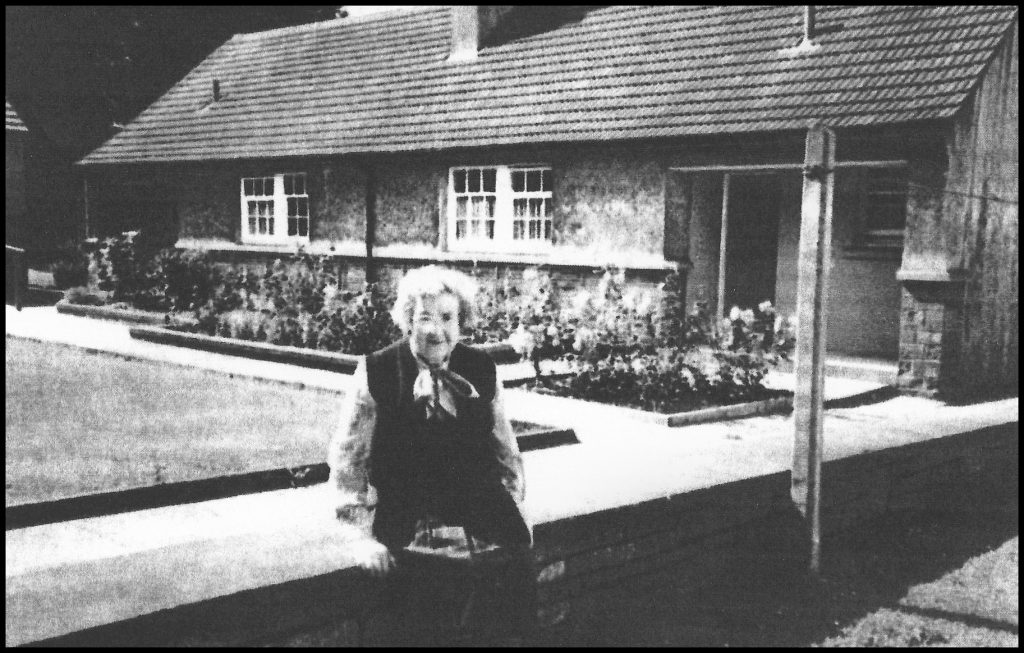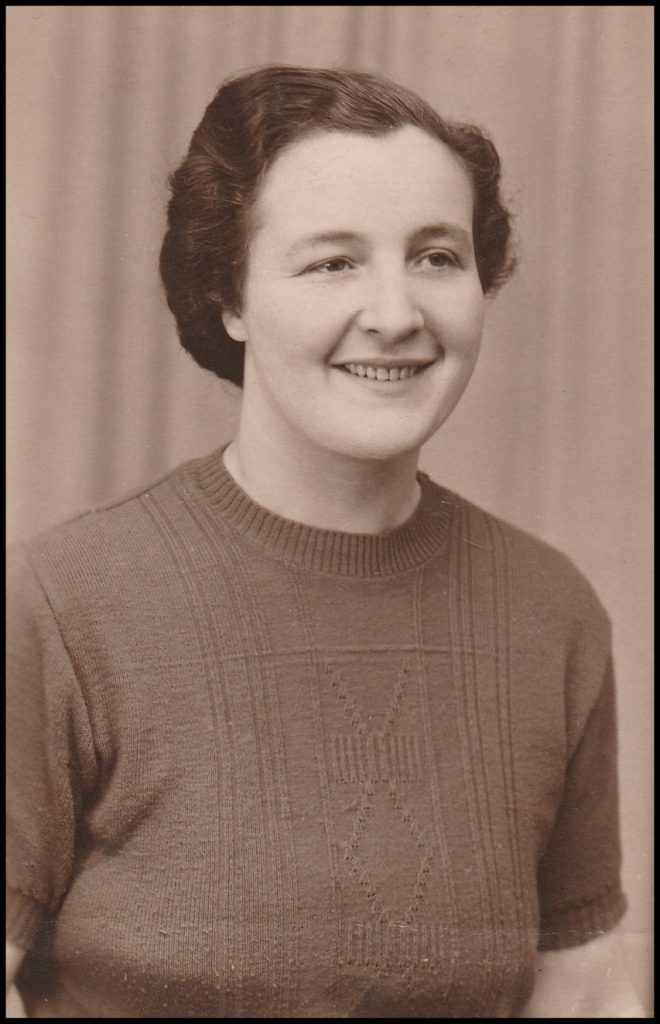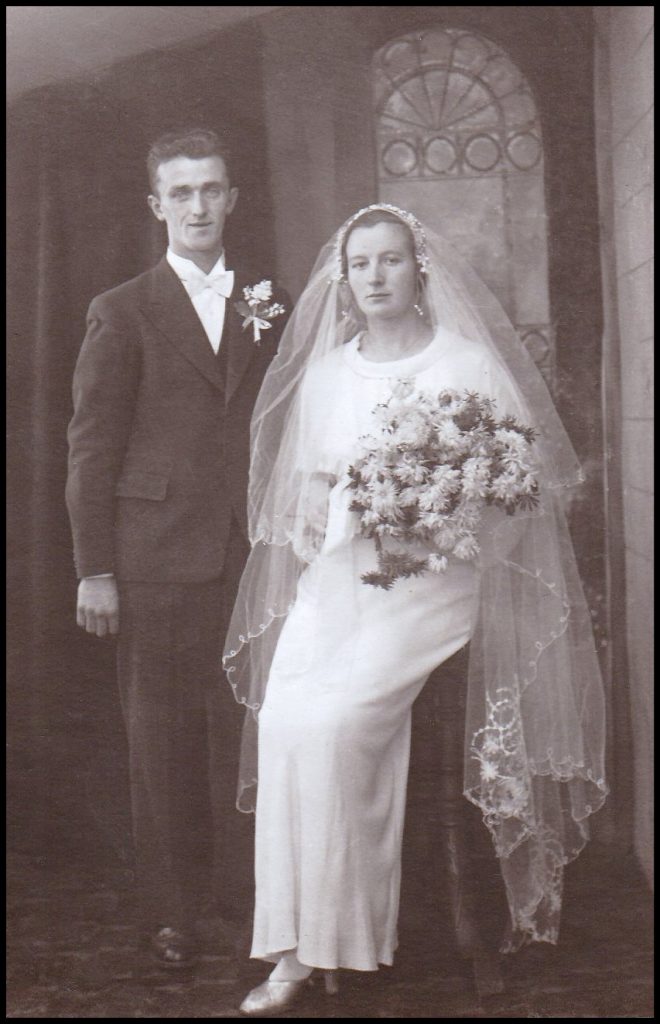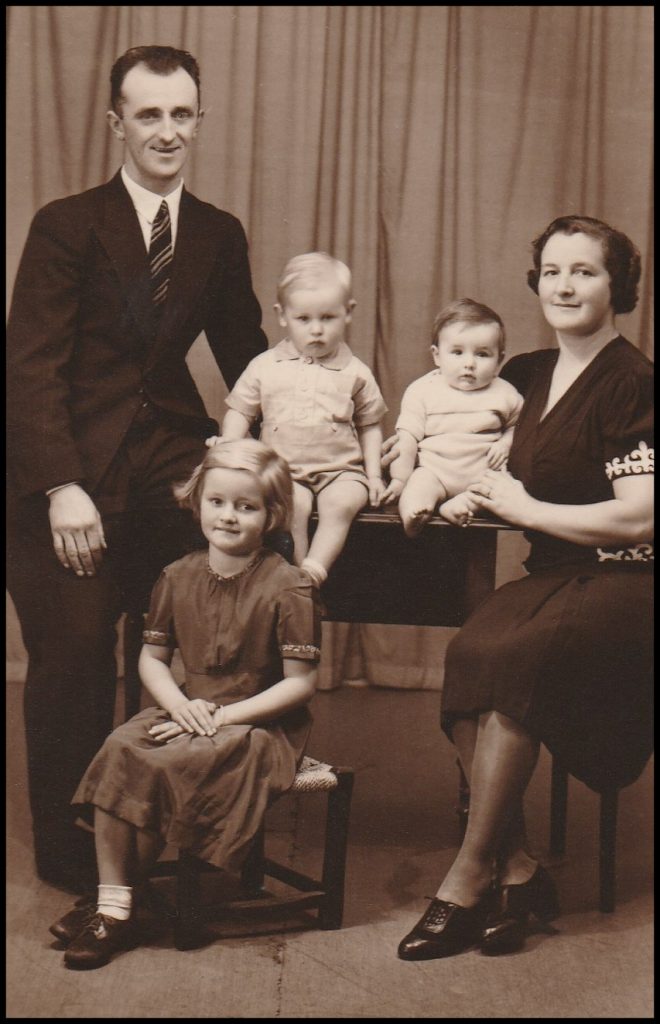Memories of Margaret Liddle
Mrs Margaret Liddle, who died on 24th January 1996, was a long-serving member of St Magnus Cathedral, and a dedicated member of the Women’s Guild. As well as being good at painting, sewing and knitting, Margaret was also good at writing. She was encouraged by her grandson, Dave Gray, to write down her childhood reminiscences, and the Rev. Ron Ferguson quoted from some of them at her funeral service.
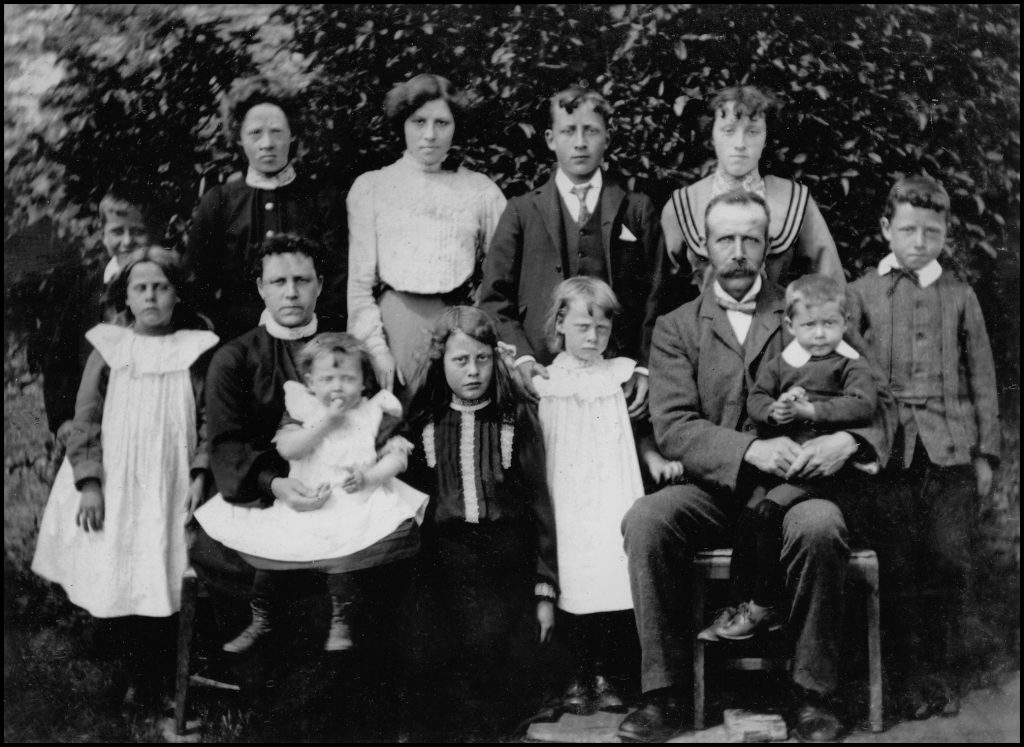
taken at Knarston, Rousay, c1905. Her brothers and sisters are, standing, from the left:
William, Janet, Maggie Jean, John, and Agnes. In front are: Lizzie, mother Margaret
Skethaway with Cilla, Ann, Minnie, father John Corsie with Peter, and Tommy.
[Photo courtesy of Tommy Gibson]
Margaret Craigie, as she was, was born at the Post Office house, Hullion, in Rousay 83 years ago, the eldest of a family of four. Margaret’s mother was one of a family of 12 and lived at Knarston. Margaret had happy memories of family days at her grandmother’s house. Here is what she wrote – shortly before she passed away in 1996:
I do not know when exactly it happened but at some point in later life I stopped looking forward and began looking backward to days gone by. I do not know what the future holds for me but at the age of eighty three years I certainly have a lot to look back on. Memory is a strange thing and cannot be relied on to recall and fill in all the gaps in a long life. A rnarvellous book called “Rousay Roots” written by my cousin Robert Marwick has been a great source of inspiration and has spurred me on to put pen to paper before it is too late. I know most of the families in the book and it has been a great joy to trace the generations as they come up.
I was born at the Post Office House, Hullion in Rousay in the year 1912, two years before the outbreak of the first world war in 1914. During those early years the world was to me a very busy place indeed, for all the war messages and soldiers coming on leave had to pass through the post office. My grandfather was the postmaster and my Aunt Bella had to go away to be trained how to use the morse code. There were no telephones as such in those days and I can remember the tapping of that machine as it was dotting and dashing at all times, day or night. Sometimes the news was very sad and many tears were shed before that war was over. At that tender age I did not really know what was happening and was enjoying a normal happy childhood. At this stage I would like to mention my parents. My father, John Sinclair Craigie of Hullion married Agnes Corsie of Knarston. I was their first born and they named me Margaret Mary after both my grandmothers. My father came from a family of three – two sisters and himself. My mother came from a large family of twelve, five boys and seven girls. Their mother died at the early age of thirty seven, not long after the birth of the youngest of that large family. Being the second oldest my mother had to bring up all the younger members until she married and the next oldest took over. As I write this the youngest son George is still living in Canada and is well over ninety.
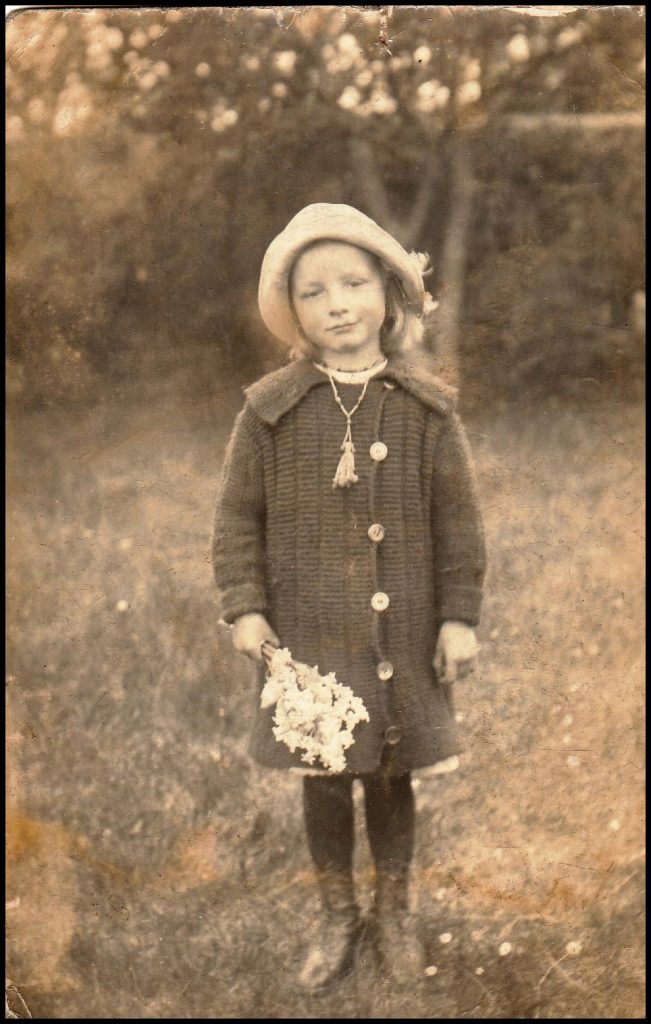
Big families make happy homes and Knarston was a happy place. I can recall many happy times spent there even when my very young days were behind me. We usually went there on Sundays and I can remember especially dinner time. If there is such a thing as organised pandemonium, that was it. The large table could not accommodate all the family as the younger members including myself had to eat at the girnel. The girnel was an important item of furniture in all farm kitchens. It was a huge wooden box almost filling one wall of the house. Its purpose was to hold the oatmeal and beremeal in separate compartments with hinged lids. The girnel was higher than the table so we had large quern stones to stand on. This did not detract from the lovely soup made about a big fat hen or a chunk of pork. The novelty of standing at the girnel was great. The quern stones were different sizes and had originally been used for milling.
Back now to the very early days and the continuing war years. My father was a joiner and no work being available in Rousay he went south to find a job. He went into construction work at Invergordon and later at South Queensferry. From time to time he came home on leave and always brought me lovely presents. Gifts of something to wear were my favourite and pleased my mother as well. I can remember getting a set of “fur and muff’. The fur had a little animal’s head at the one end and a tail at the other – this was worn round the neck and suspended from it by a cord was the muff worn to keep the hands warm. I must have looked like something out of “Little Women” by Louisa M Alcott.
Margaret in Rousay aged (we think)
about 8 which would make it 1920
Big families make happy homes and Knarston was a happy place. I can recall many happy times spent there even when my very young days were behind me. We usually went there on Sundays and I can remember especially dinner time. If there is such a thing as organised pandemonium, that was it. The large table could not accommodate all the family as the younger members including myself had to eat at the girnel. The girnel was an important item of furniture in all farm kitchens. It was a huge wooden box almost filling one wall of the house. Its purpose was to hold the oatmeal and beremeal in separate compartments with hinged lids. The girnel was higher than the table so we had large quern stones to stand on. This did not detract from the lovely soup made about a big fat hen or a chunk of pork. The novelty of standing at the girnel was great. The quern stones were different sizes and had originally been used for milling.
Back now to the very early days and the continuing war years. My father was a joiner and no work being available in Rousay he went south to find a job. He went into construction work at Invergordon and later at South Queensferry. From time to time he came home on leave and always brought me lovely presents. Gifts of something to wear were my favourite and pleased my mother as well. I can remember getting a set of “fur and muff’. The fur had a little animal’s head at the one end and a tail at the other – this was worn round the neck and suspended from it by a cord was the muff worn to keep the hands warm. I must have looked like something out of “Little Women” by Louisa M Alcott.
About this time strange things began to happen at our house. My Craigie grandparents and my Aunty Bella and her husband lived in one part of the house and my father and mother and myself lived in another part called the “back house” with its own door into the garden but all under the same roof. By a strange coincidence completely unplanned I am sure, both my mother and my Aunty Bella were expecting babies about the same time. At that time the word pregnant had not reached everyday use as it has today. In Rousay the term used for a woman in that condition was “in the family way”. I, of course, was quite unaware of what was going on. As there was no resident doctor on the island at that time and difficulties could arise getting one across from Evie, they both made arrangements to go to Kirkwall to have their babies. To Kirkwall yes, but not to the Balfour Hospital or any hospital at all for at that time there were no maternity facilities as now. It was only then that my Granny whispered in my ear that I might be getting either a little brother or sister. My mother went to stay with my Uncle John and his wife at Orquill where he was a farm servant and Aunty Bella stayed with friends at Sulisquoy. Now another coincidence – they both had their babies on the same day, the 9th of February – at which time I was only three years and eight months old. They had a great welcome home – Anna Evelyn Craigie and Mary Isabella Kirkness Yorston. My sister lives in Stromness now and Mary is in Australia. It is not difficult to guess the competition that took place between the two mothers. At that time I was only aware of the fact that I was being overlooked, in fact almost ignored.
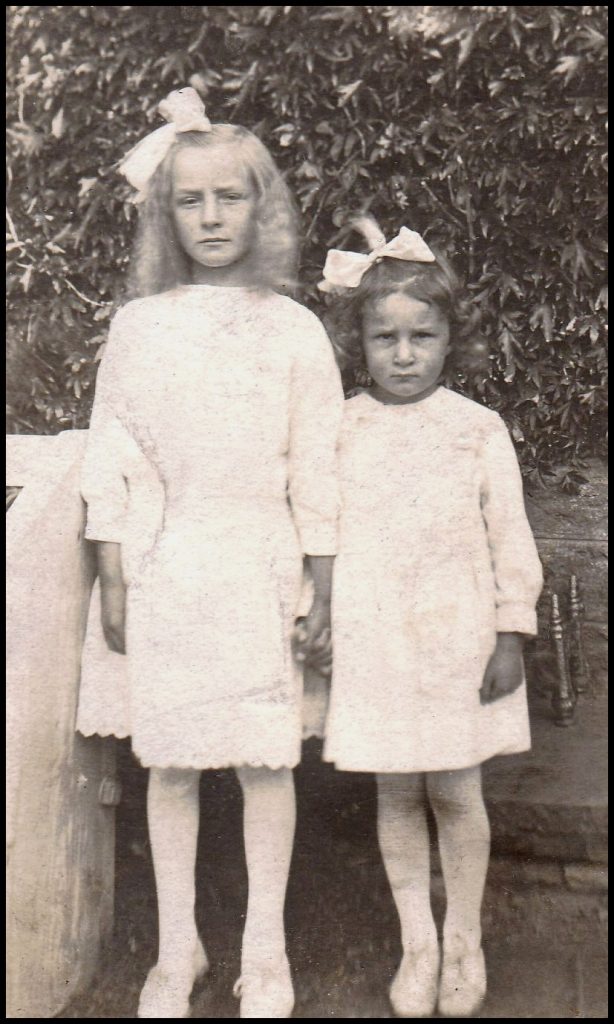
Details of the real competition and also the funny side of it have been passed on to me as I grew up. One of these incidents I would like to relate and which I do vaguely remember myself. Visits from the tinker community were frequent and always added a little excitement in an otherwise quiet day. The day in question was brightened by a visit from Jessie Ellen Newlands and her baby daughter Tibby to the post office house. There she was with her pack on her back and the bairn at the front, skilfully wrapped in a large tartan shawl where Tibby snuggled cosily against her mother’s breast. Tibby however was not being breast fed, as a small lemonade bottle with a teat on the end of it was in evidence. Both the Rousay mothers were there with their offspring. When asked when Tibby was born her mother answered “sometime in February, I’m no sure o the date”. Mary and Anna were born on the ninth of that month too, so you can guess the look on both mother’s faces when Jessie Ellen opened her shawl and let them see her bonny big baby. Tibby was very much bigger than the resident babies. Auntie asked what she was feeding her on and the answer was “nestles milk missus, thinned doon wi water”. There was much talk about this after the tinky wife had gone for it plainly states on the condensed milk tin – not suitable for babies. Tibby however thrived on it and grew up to be a woman of ample proportions. lf I remember rightly she did not live to an old age. There are no tinker families in Orkney now, not as a separate community anyway. They have married and mixed with the Orkney folk and life goes on as it should with no class distinction.
Margaret with her younger sister Anna
in Rousay in (we think) 1924
Old traditions die hard and it’s not easy to forget the thrill of seeing small reekie tents sprouting up along the burn and the lovely smell of stolen peats wafting in the air. Also the clanging of the real old tinker men (tinsmiths) as they hammered their varied shapes and sizes of pails and other utensils. Every home had a jeck and several tinnies. The tinny was the forerunner of the mug and a jeck was about a two pint size with a handle at one side.
I can remember the screechy slates and the smell of chalk – and the names of the other pupils at the school. It was a pleasant walk to school – about a mile I would say. On the road or path between the school and the public road, there was a big flat rock, level with the ground, that carries a somewhat unhappy memory for me. A boy called Billo o’ Corse began school at the same time as I did, and we used to get out of school earlier than the rest to go home. I used to get on to the flat rock and dance about and swing my school bag. One day Billo tried to push me off this stone and we had a bit of a fight. In the end I hit him across the face with my school bag – and bled his nose. I was terrified then when I saw what I had done. He was howling and threatened me by saying his “faither” would be ower at the Post Office that night to get this sorted. I took a long time getting home that night for I was really scared stiff. However, I came to Breck which is a house not far from home, here was my mother coming to look for me. In tears, I told her what had happened, making out of course that I was not to blame, so I expect she wiped my tears away and comforted me. Billo’s “faither” never appeared, so that was then end of that. The lovely flat stone was thereafter avoided, and school life continued until we moved across the sea.
I cannot remember any mention being made, previous to our moving. Of course, everything in those days was very hush-hush, and nothing was said in front of the children. I do remember being terrified of the boat as I had never been on one before. It was a big open boat, used for crossing with the mails and other goods…..We were met at Evie pier by Marwick of Furson’s horse coach. To me this was a very grand affair, and a welcome sight after the sea crossing. My father and mother and Anna and myself got cosily seated among the helter-skelter of rugs and blankets and baskets of food, and off we set on the unfamiliar path to somewhere…..
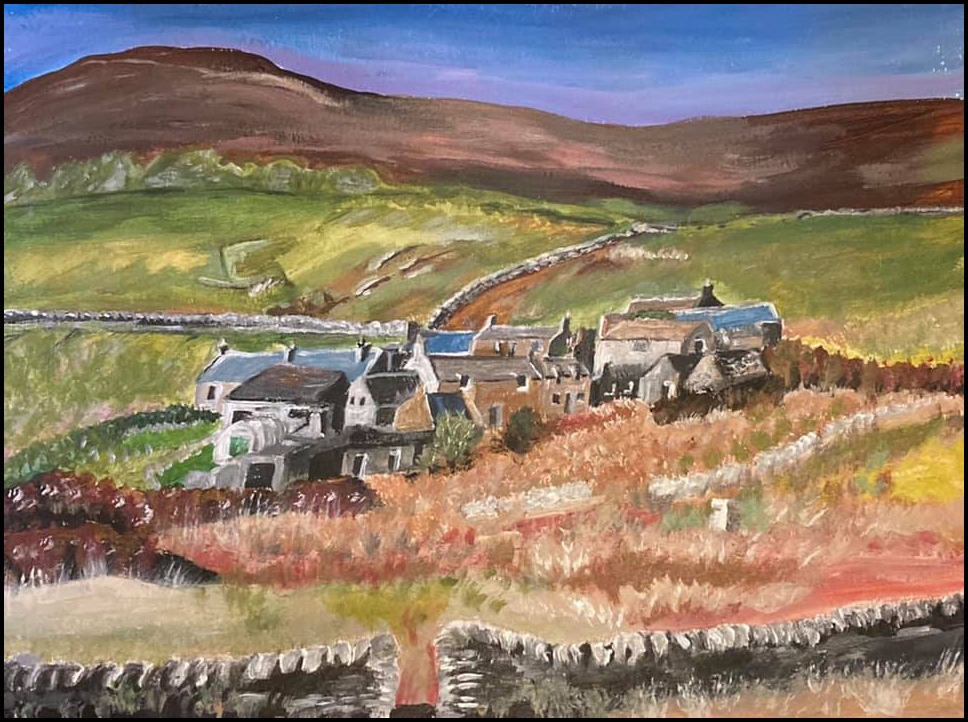
A recent painting of Hullion by Claire E Rowlands, who writes:- “Margaret was my dad’s sister. My dad was Sinclair Skethaway Craigie. There were 4 siblings. Anna, Margaret, John and my dad. I used to visit Margaret and Willie when they lived in Palace Road. She was very wise.”
Margaret’s memories of her Rousay upbringing and the photos
of her and her family are courtesy of her daughter Jean Gray,
Kirkwall. My thanks to her, and her son Dave for locating and
sharing their treasured material.
